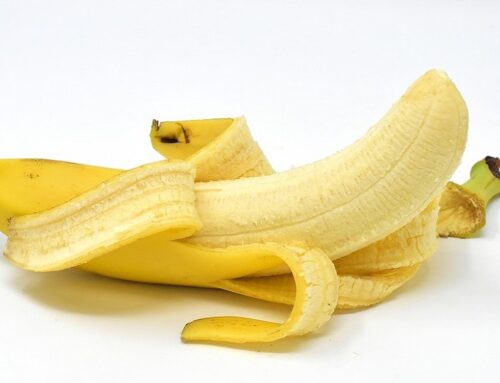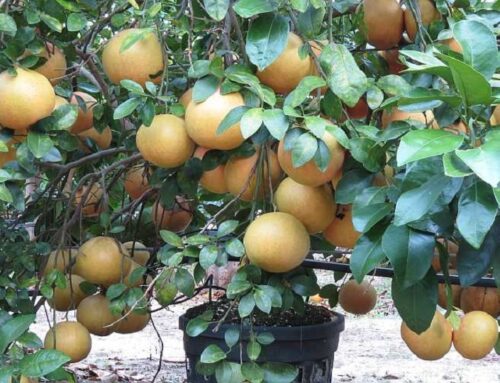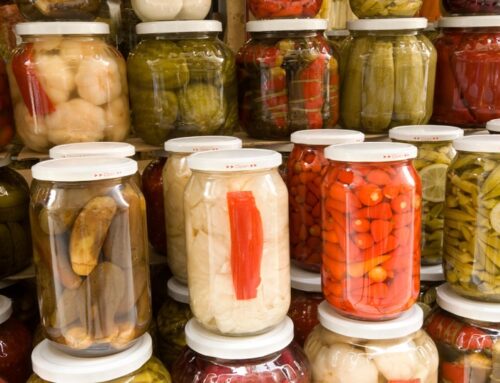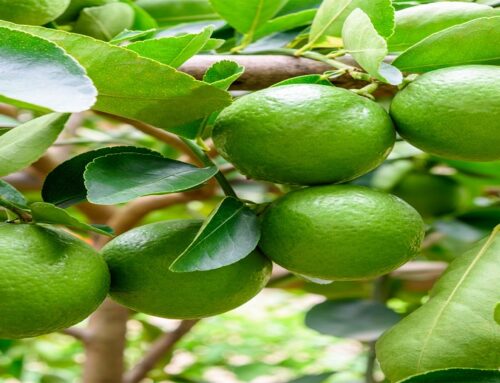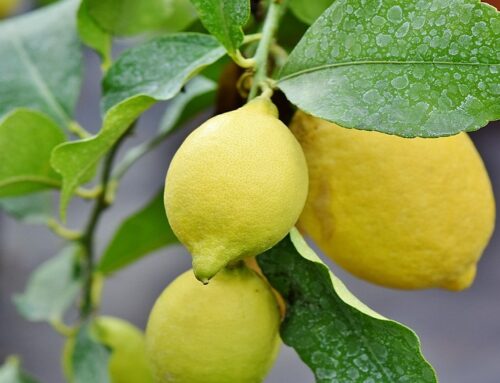Scientific name of sweet oranges is Citrus sinensis. It belongs to the family of Rutaceae. It is originated in South-East Asia. Sweet Orange is a hybrid between pomelo (Citrus maxima) and mandarin (Citrus reticulata).
Plant Description: Citrus sinensis is a small evergreen, perennial, flowering tree with a shallow root system. Under good cultural conditions, the tree reaches up to a height of 10-12 meters. Trees have angled twigs and stout spines. These trees are commercially cultivated in subtropical regions for their sweet fruits, i.e. oranges. Oranges can be eaten fresh, or processed into orange juice, squash, marmalade and similar other products. Leaves are oval-shaped and dark green with alternate arrangement. Petioles are winged. Flowers are axillary and borne solitary or in small groups. Fruit is a hesperidium, a modified berry with slightly acidic, juicy pulp. Fruit is subglobose shaped and contains small seeds. Like all other citrus fruits, sweet oranges are non-climacteric fruits.
Varieties: Citrus sinensis group consists of 4 types of sweet oranges; these are:
- Common Oranges
- Blood or Pigmented Oranges
- Navel Oranges
- Acidless Oranges
Common Oranges: Common oranges are the most popular type of sweet oranges and constitute about two-thirds of world’s orange production. Common oranges are used mostly for juice extraction.
Blood Oranges: Blood oranges have dark red coloured rind and flesh because of the high concentrations of anthocyanin present in them. These oranges are suitable for juice extraction. Popular varieties of blood oranges are Maltese, Moro, Sanguinelli, Scarlet navel and Tarocco.
Navel Oranges: Navel oranges have a thick fruit skin and therefore it is easy to peel these oranges. Navel oranges are less juicy and has a slight bitter taste and hence not suitable for juice extraction. Navel oranges can only be propagated through cutting and grafting. Popular varieties of navel oranges include Bahianinha or Bahia, Dream Navel, Late Navel, Washington or California Navel and “Cara cara oranges” or “red navel“. Red navel oranges are sweet and low in acid and fruit flesh is pinkish red.
Acidless Oranges: Acidless oranges are, as the name suggests, contain very low levels of acid and therefore very sweet. These oranges are fit for fresh consumption and not suitable for juice extraction. Since acid levels are low, these oranges are highly perishable than other oranges.
Major Hybrids of Sweet Oranges: Grape fruit, orangelo, and Clementines are some popular hybrids of sweet oranges.
- Grapefruit: A Cross Between Sweet Orange and Pomelo
- Orangelo: A Cross Between Grapefruit and Sweet Orange
- Tangors including Clementine and Murcott: A Cross Between Sweet Oranges and Mandarin Oranges or Tangerines
Orange Fruit Characteristics: Fragrance of oranges is due to octyl acetate, a volatile compound present in orange fruits. Taste of oranges is due to the presence of sugars and acids. Higher sugar to acid ratio is preferred for oranges. Orange taste tends to increase when the fruits reach harvesting maturity because fruit has a higher sugar/acid ratio which makes the fruit sweeter with less bitterness. Just like other citrus fruits, oranges are also acidic fruits.
Health Benefits of Oranges: Oranges are an excellent source of vitamin C which is essential for increasing body’s natural immunity. Oranges are rich source of antioxidant phytochemicals such as carotenoids and flavonoids; hence are able to lower the risk of lifestyle diseases such as cancer. Oranges are rich in potassium, an essential mineral that helps in lowering blood pressure.
Food Uses of Oranges: Oranges are used as a dessert fruit. It is used for making juices, juice concentrates, squashes and marmalade. Fruit peels are used for extracting sweet orange oil. Orange oil is used for food flavouring purposes, cosmetic uses and for aromatherapy. Orange peels are used for making pectin also.
Grading of Oranges: Grading of orange fruits is based on the following parameters such as Colour, Size and Shape of Fruits; Texture and Firmness of Fruits; Maturity of Fruits; and Varietal Characteristics. Juice grades are determined by the juiciness of the orange fruits, the amount of solids in the juice, and the proportion of anhydric citric acid in fruit solids.
Growing Oranges: A detailed account of growing practices for orange trees as follows:
Climatic Requirements: Orange trees are essentially a plant of subtropical climate. Wet tropical climate and high altitudes are not suitable for the growth of Citrus sinensis plants. However, they can be grown indoors in cool climates. Oranges thrive well between 15.5 and 29 °C. They are sun-loving plants and require considerable amounts (10-12 hours daily) of sunshine. They need plenty of water also for their growth; however high humidity should be avoided as it may invite plant diseases. For fruit development, there should be a temperature variation between summer and winter and, between day and night. Oranges are sensitive to frost and hence frost-protection is mandatory.
Soil: Oranges can be successfully grown in well-drained, fertile, light or medium loam soils. Oranges thrive well in well-drained alluvial, medium black and loamy soils also. Soil pH should be between 5 and 8 (moderately acidic to slightly alkaline soils).
Propagation: Seed propagation may be done for a small crop. For a commercial crop, grafting and budding may be used. In grafting, a rootstock is grown from seed and then bud from a scion variety is grafted into the one-year old seedling rootstocks. While choosing a rootstock, make sure that it is compatible with the variety/scion inserted into them. Otherwise the graft will not survive for a long period. Grafted trees mature uniformly and bear fruits earlier than seedling trees. Grafted trees begin to bear after 3-4 years of growth while a seedling tree begins to fruit after 5-6 years only.
Field Preparation: Field is tilled, and organic matter/humus is added to the top soil; alternatively green manuring may be done to increase soil fertility. Orange trees are susceptible to heavy winds and hence wind protection should be provided in the fields. Pits of size 50x50x50cm are prepared well in advance and left for weathering
Planting: One year old grafted plants are planted in well-manured pits at the onset of rains. Plant to plant distance may be kept at 4-5 meters while distance between two rows may be kept at 9-10 meters. A light watering is done soon after planting.
Irrigation: Irrigation should be given at 10-15 days interval during winter. Weekly irrigation is recommended during summers. Water requirement of young (1-4 years old) plant is about 5 to 15 liters/day. Water requirement of a mature plant (9 years and more) may be 60 to 170 liters per day. Irrigation should be planned according to the plant requirement and prevailing climatic conditions.
Aftercare: Pruning is not required for mature plants but slight pruning may be done for young plants to keep them in shape. Mulching may be practiced to suppress weed growth and to conserve soil moisture. Growth regulators may be sprayed to avoid pre-harvest fruit drop.
Disease Management: Gummosis is a serious disease, caused by the fungus Phytophthora spp.; it affects tree bark which develops cracks and dried cankers; bark of the affected trees can be pasted with Bordeaux mixture in order to control this disease. Citrus greening disease is caused by the bacterium Liberobacter asiaticum; major symptoms are streaks on the leaves, and deformed fruits; this disease can be controlled by the use of disease-free planting materials. Greasy spot is a fungal disease caused by the Mycosphaerella citri; major symptoms are premature defoliation; Bordeaux mixture may be used as a control measure.
Insect-Pests Management: Major pests of orange plants are bark borers, leaf miners, white flies, fruit flies, and citrus psylla. A detailed account of inset-pest management in orange plants is given below:
- Bark borer (Inderbela tetraonis): These caterpillars make holes in the branches; they can be effectively controlled by injecting kerosene in the holes and plugging the holes thereafter.
- Citrus Psylla (Diaphorina citri): These insects can be controlled by the use of its natural enemies, ladybird beetles.
- Citrus leaf miners (Phyllocnisitis citrella): These larvae feed on tender plants; these insects can be controlled by destroying the affected plant parts and also by the application of organic, pyrethrum based insecticides.
- Citrus whiteflies, citrus butterflies, and citrus aphids: All these insects attack on young leaves and tender shoots by feeding on them; they can be effectively controlled by the application of organic, pyrethrum based insecticides.
- Citrus fruit flies: These insects attack young and ripening fruits and can be controlled by the destruction of affected fruits as well as by the use of fly traps.
- Other major insects are scale insects, thrips and mealy bugs; they can be effectively controlled by the application of organic, pyrethrum based insecticides.
Harvesting: Oranges are non-climacteric fruits and hence only mature, ripe fruits should be harvested. Ripeness of oranges can be determined by the changes in fruit skin colour. Ripe oranges have greenish to yellowish green skin colour. During storage, ethylene gas is used to turn green skin to orange colour; this process is called degreening.
Storage: Oranges can be stored at refrigeration temperature in controlled-atmosphere chambers for up to 3 months after harvest. In home storage, oranges can be stored for one month if they are stored loosely in a perforated plastic bag at refrigeration temperature.
We have a book on ‘Citrus Fruits‘….
Check out our publishing services here…
We publish top quality videos on various ‘Food & Agriculture’ topics. You may subscribe our video channel here…


